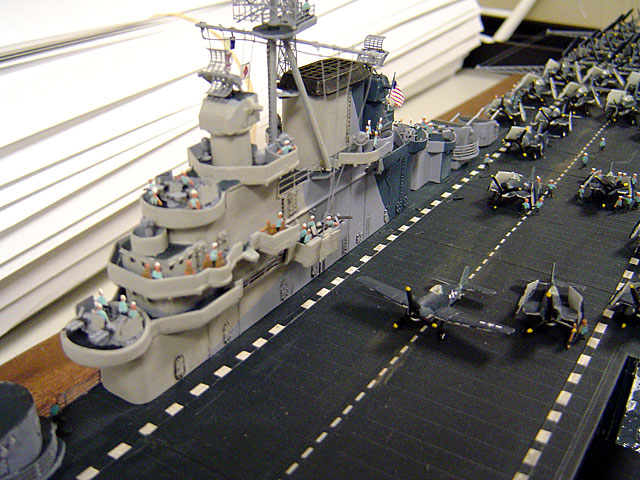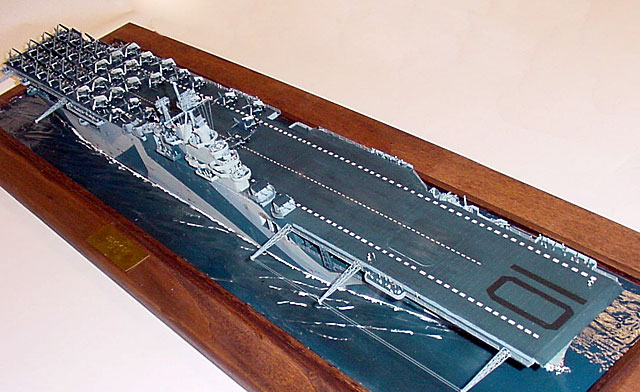|
USS Yorktown CV-10
by
Rick Cotton
|

|
|
USS Yorktown CV-10 |

Trumpeter's
1/350 USS Essex is available online from Squadron
If there was one weapon that
doomed the Japanese Empire in World War Two, it was the Essex-class
carriers. Big, fast, tough, hard-hitting, and numerous, they carried the
US Navy from the savage combat of 1943 to the Japanese surrender in Tokyo
Bay.
Ship modelers the world over
have long hoped for a 1/350th scale injected kit of one of these vessels,
and Trumpeter of China has finally answered that call.
Having completed a Trumpeter
1/350th Hornet recently, I was thrilled to get my hands on one of these
kits. Having read the reviews on the web, I was ready to go and bury
myself in styrene and photoetched brass, and this kit doesn’t disappoint.
Great detail, hundreds of parts, a correctly shaped hull, and super
looking aircraft, this is a fantastic ship model. It depicts an early
series Essex-class ship (but not Essex, as she never carried only one
catapult).

Later ships in the series
got additions of a second catapult, and 40mm gun mounts to the starboard
side at the hangar deck level and other locations. Of course, the early
ships also got those modifications during refits, so check your references
carefully.
Most of the early “short
hull” ships can be built from this kit. I chose to model CV-10 Yorktown, a
veteran of most of the war from 1943 on, as she would have appeared in the
summer of 1944, before her major September refit. Yorktown was, of course,
named for the sunken CV-5 Yorktown at Midway.
I had no idea at the time
that Trumpeter’s next issue of this kit would be as Yorktown, CV-10.
Oh,well.
Fit of the hangar deck to
the hull was not quite as tight as the Hornet had been…I used a bit of
putty to get the seams closed. The island parts also need a bit of putty
to close some small gaps here and there. Fit overall was pretty good, but
seemed just a hair less tight than Hornet. Take care and sand and test-fit
on this baby.
The biggest complaint I had
with Hornet…the lack of interior hangar detail… is almost totally
rectified in this kit. Unfortunately there are also a lot of ejector pin
marks on the inside surfaces of the bulkheads. I sheeted these over with
thin styrene sheet, cut to fit. I also added Plastuct I-beam detail to the
underside of the flight deck. Most of the hangar doors were cut open, to
show the hangar deck details. I built up and added some of the air group
to the hangar deck at this point, along with some mechanics and other
crewmen from the Tom’s Modelworks photoetch crew set. The idea was to
create a busy-looking, working ship.

I had to build and paint in
layers, working from the waterline up, due to the complexity of installing
the photoetch and masking for the camouflage scheme. I left the gun tubs
and platforms off, and the flight deck unglued until the completion of the
“dazzle” paint scheme, in order to be able to mask off the hangar openings
and easily remove the masks when painting was complete.
Photo Etch
The Tom’s Modelworks set for
this ship, although expensive (around $45 US), is very extensive and
complete, providing both ship and aircraft details. Along with the usual
railings and other items, there are stairs with tiny little steps and
railings, armor for the gun mounts, and the late-war radar assemblies are
flat out incredible. They are also extremely intricate and delicate,
especially the large round units. Take your time and work calmly on these,
they really are buildable, and the results will cause groans of envy from
your competitors at the next contest. Unfortunately, Yorktown didn’t have
these units in mid-summer 1944, so I used the earlier SK units instead.
Also, there is nothing on the tripod mast in the kit’s superstructure for
the signal flags to fly from (Navy vets out there, what is this thing
called?). I scratchbuilt mine from brass and wire, with 1-pound fly
fishing thread for the lines.

Many well-known color photos
of CV-10 show her with a prominent black stripe running down the center of
her blue-stained, but well-worn flight deck. This is correct for her
shakedown and 1943 cruises, but photos of her in summer ’44 show her
flight deck with the later white dashes on, again, a worn, blue stained
deck. Thus, the dashed line decals that come with the kit are appropriate
for a centerline from ‘44, but I had to create decals for the outer dashed
lines in white.
The big “10”’s were made
from the kit’s ”9”’s, trimmed and converted using black decal sheet. A
little gray drybrushing weathers these numbers to match the deck.
Air Wing
The aircraft are as good or
better than the Hornet kit’s planes (the SBD’s are identical), but,
although they are in the color prints included in the instructions, there
are no Helldivers included with the kit. You’ll need to purchase the extra
sets if you want “Beasts” on your flattop. Check your references. Many of
the Essexes didn’t embark Helldivers until late in the war.
Yorktown’s first skipper,
Capt. J.J ”Jocko” Clark hated them so much he ordered them offloaded and
replaced with SBD’s at the end of Yorktown’s shakedown cruise. Clark even
recommended the entire SB2C program be cancelled! They came back on in
1944, albeit in a much improved model.
Trumpeter’s Helldivers are
indeed a later 4-blade prop version, although exactly which mark I don’t
know.
The Tom’s Modelworks set
does include parts for four Helldivers, especially the prominent landing
gear doors. I have to wonder if the new “Yorktown” release of this kit
announced on the Squadron website has the SB2C’s and the extra late-war
40mm gun mounts and sponsons? I sacrificed my SBD’s to beef up Hornet’s
air group, and bought some extra SB2C’s, TBF’s and F6F’s for my Yorktown.

Also, take great care
removing the Avenger and Hellcat props from the sprue. They are quite
fragile, and I had to use a sharp single-edged razor to do it. If do you
break them, there are brass ones in the Tom’s photoetch set.
I posed my ship in the midst
of spotting her second strike of the day somewhere in the middle of the
Pacific. There are 20 planes in her hangar, along with the group being
readied for launch on deck. The rest are somewhere else, making life
miserable for the Imperial Japanese Navy. The “water” is acrylic silicone
caulk spread over a deep blue-painted base, with a final coat of Future on
top. I don’t know how many of those teeny little *&^%$#@ Tom’s Modelworks
sailors I ended up using, probably 400or so, but I’m cross-eyed now, and
sick of painting them for a while.
In short, this kit raises
the bar again for boat freaks like me. The biggest drawbacks were the
ejector pin marks and the few aircraft in the kit, but both are easily (if
not cheaply) remedied. Fit is pretty good, not great, detail is
outstanding, and subject matter is a must-have. Well done, Trumpeter. Now,
launch that Lexington! With what Trumpeter seems to have learned on Hornet
and Essex, CV-2 should be incredible! Who knows what lies down the road….Akagi?
Taiho? Independence? Zuikaku? I sure do hope so.
Click on the thumbnails
below to view larger images:
Model, Images and Text Copyright ©
2003 by Rick Cotton
Page Created 12 June, 2003
Last Updated
17 March, 2004
Back to
HyperScale Main Page |
Home |
What's New |
Features |
Gallery |
Reviews |
Reference |
Forum |
Search